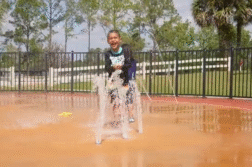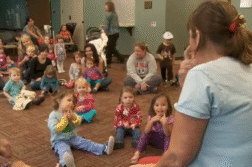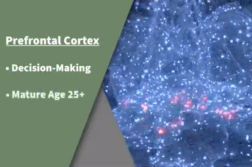DENVER, Colo. (Ivanhoe Newswire)— Every year eight million babies are born with genetic disorders passed down from generation to generation. One family didn’t even know they carried a problematic gene until an ultrasound revealed it in their unborn baby. They were given little hope their little girl would survive, but through strong faith and the help of a team of medical experts, she is thriving today. Miracle baby
Little Payton Calvillo is a cheerful … loving little sis.
“She’s a complete miracle baby,” expressed Payton’s mom, Ahna Calvillo
When her mother Ahna was just five months pregnant she was told her unborn baby would probably not survive birth.
“It was pretty much a death sentence from the beginning,” Ahna recalled.
Payton’s bones were breaking and bending inside the womb.
“She likely had a problem where she couldn’t make alkaline phosphatase properly,” explained Sunil Nayak, MD, a pediatric endocrinologist at Rocky Mountain Hospital for Children.
Needed for bones to grow and strengthen. There was little anyone could do. Nineteen different specialists were on hand for the C-section delivery.
“They even asked us the question that morning, how far do you want us to go? Do you want a ventilator on her? Just how far do you want us to prolong her life? Our ultimate hope and goal was that she would come out and breathe on her own,” shared Ahna.
And then …
“She just came out screaming. She came out crying. She breathed on her own right away. She was perfect,” exclaimed Ahna.
Payton was diagnosed with hypophosphatasia, a disorder that weakens bones. She was immediately placed on a new FDA approved medicine
“Here we are just one year later at one year of age and you see a dramatic difference in the shape,” illustrated Jaren Riley, MD, a pediatric orthopedic surgeon at Rocky Mountain Hospital for Children.
Before the medicine, 75 percent of all patients died by age of five. Now there is a 97 percent chance Payton will live a normal life.
“My baby was broken and that’s what I needed God to do- a miracle,” shared Ahna.
Payton will stay on the new medication for the next few years and then doctors will re-evaluate whether she needs to continue. The Cavillo family didn’t know that they had the HPP gene. After being genetically tested, Payton’s mother and grandfather are positive. Neither one has ever suffered from weak or broken bones.
Contributors to this news report include: Cyndy McGrath, Executive Producer; Marsha Lewis, Field Producer; Rusty Reed, Videographer; Roque Correa, Editor.
To receive a free weekly e-mail on Medical Breakthroughs from Ivanhoe, sign up at: http://www.ivanhoe.com/ftk
MEDICAL BREAKTHROUGHS
RESEARCH SUMMARY
TOPIC: MIRACLE BABY PAYTON: BROKEN INSIDE THE WOMB
REPORT: MB #4797
BACKGROUND: Hypophosphatasia (HPP) is a rare genetic disorder characterized by the abnormal development of bones and teeth. These abnormalities occur due to defective mineralization. Mineralization is the process by which bones and teeth absorb minerals such as calcium and phosphorus, which are required for hardness and strength. When this doesn’t happen, bones become soft and prone to fracture and deformity. There are six major clinical forms of HPP that range from an extremely severe form that can cause stillbirth to a form associated with only premature loss of baby teeth. HPP is caused by mutations in the tissue nonspecific alkaline phosphatase (ALPL) gene. This gene is also known as the TNSALP gene. Such mutations lead to low activity of the tissue nonspecific alkaline phosphatase enzyme.
TREATMENT AND MANAGEMENT: There are currently no approved treatments for hypophosphatasia. Treatment is focused on managing symptoms and complications to help patients stay active and maintain their quality of life. This may require the expertise of pediatricians, dental experts, and orthopedic surgeons to devise a treatment plan that meets all of a patient’s individual needs. Physicians may prescribe non-steroidal anti-inflammatory drugs (NSAIDs) to treat pain in the bones and joints, although these must be prescribed with caution due to the number of side effects associated with excess doses or long-term use. Vitamin B6 may be administered to control seizures in severely affected babies, and infants who develop hypercalcemia may have their dietary calcium intake restricted and receive treatment with calcitonin, hydration and diuretics.
(Source: https://www.news-medical.net/health/Hypophosphatasia-Treatments.aspx)
INVESTIGATIONAL THERAPIES: Bone marrow transplantation, specifically hematopoietic stem cell transplantation, has been used to treat two unrelated infant girls with HPP. One was also treated with bone fragments and cultured osteoblasts, which are bone-forming cells. ‘Cultured’ refers to cells that are grown under specific conditions outside of the natural environment (the body) and within a laboratory. Both patients showed significant, but incomplete improvement, although no more formal studies have been conducted. Then, the drug teriparatide (parathyroid hormone 1-34) has been given “off-label” to several adults with HPP with metatarsal stress fractures or femoral pseudo fractures, resulting in healing. The drug is not permitted for use in children. More research is necessary to determine the long-term safety and effectiveness of teriparatide in the treatment of HPP.
(Source: https://rarediseases.org/rare-diseases/hypophosphatasia/)
FOR MORE INFORMATION ON THIS REPORT, PLEASE CONTACT:
MARI ABRAMS
720-754-4287
MARI.ABRAMS@HEALTHONECARES.COM
If this story or any other Ivanhoe story has impacted your life or prompted you or someone you know to seek or change treatments, please let us know by contacting Marjorie Bekaert Thomas at mthomas@ivanhoe.com




